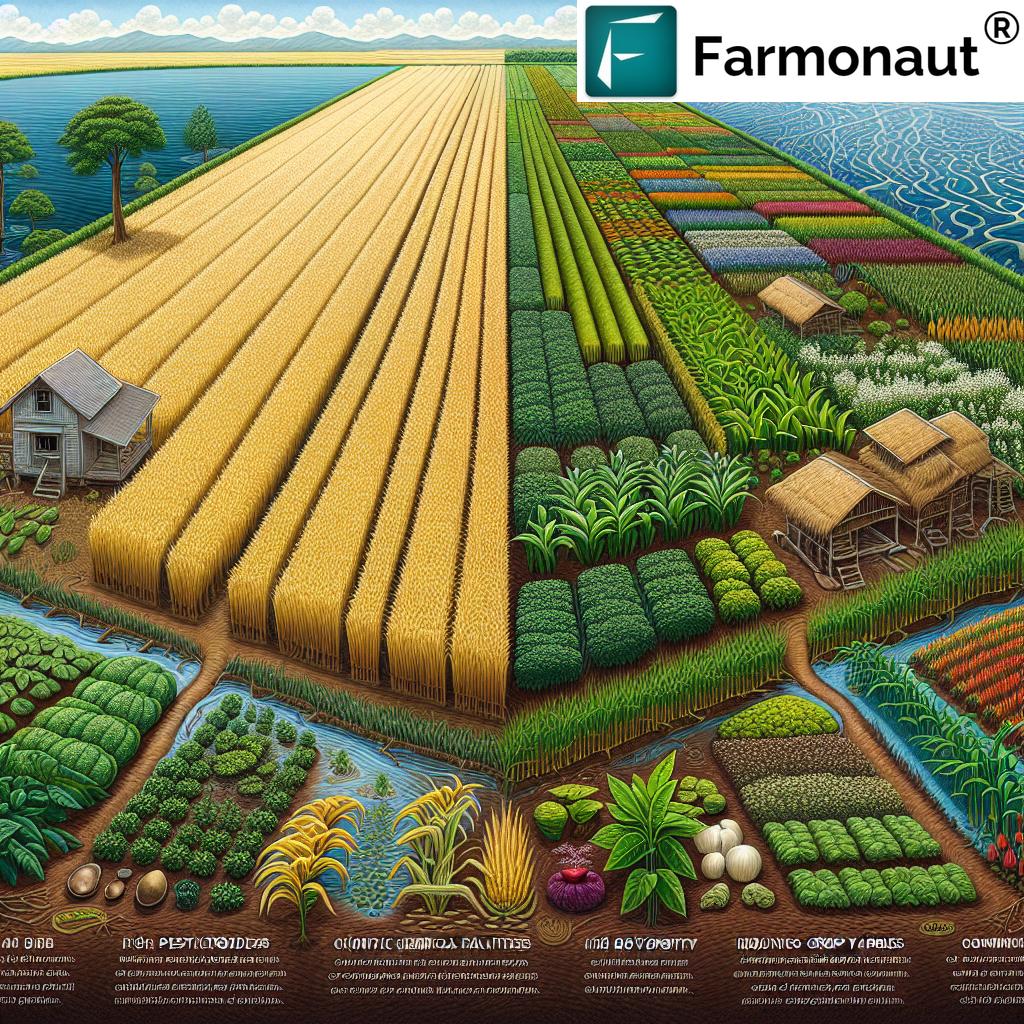What Is Green Revolution? 7 Shocking Impacts on India
Table of Contents
- Introduction: Green Revolution – Definition & Historical Context
- Origins and Development of the Green Revolution
- Key Components of the Green Revolution
- Before-and-After Comparison Table
- 7 Shocking Impacts of the Green Revolution on India
- Green Revolution and Sustainable Agricultural Practices
- How Farmonaut Empowers Modern Sustainable Agriculture
- Frequently Asked Questions
- Conclusion: Lessons from the Green Revolution
“India’s wheat production soared by over 200% between 1965 and 1990 due to the Green Revolution’s high-yielding varieties.”
Introduction: Green Revolution – Definition & Historical Context
The Green Revolution stands as one of the most transformative periods in agricultural history, particularly for India. Spanning from the 1940s into the late 20th century, this global movement introduced high-yielding crop varieties, innovative technologies, and modern agricultural practices—all aimed at dramatically boosting food production as the world’s population soared. However, alongside improved yields and enhanced food security, this revolution brought with it far-reaching environmental and social challenges.
In this blog post, we’ll comprehensively explore what the Green Revolution truly means, why it was so pivotal to agricultural production in India, and the 7 shocking impacts—both positive and negative—that have reshaped India’s crops, soil, and rural society.
Origins and Development of the Green Revolution
The phrase Green Revolution found notoriety in 1968 through William S. Gaud of USAID, referring to the global spread of new agricultural technologies. Yet its roots stretch back to the pioneering efforts of Norman Borlaug, whose high-yielding wheat varieties in Mexico set a precedent for subsequent agricultural breakthroughs. The adoption of HYVs—high-yielding crop varieties—combined with advanced irrigation techniques, chemical fertilizers, pesticides, and mechanization, resulted in unprecedented increases in food production worldwide.
Within India, the Green Revolution was championed by M.S. Swaminathan from the mid-1960s. Collaborating with international agencies, Indian scientists introduced HYVs of wheat and rice coupled with modern farming techniques. By the time famine threatened in the late 1960s, these changes enabled India to shift from a grain-deficit nation to one of growing abundance—setting the stage for the country’s agricultural and socio-economic transformation.
The Key Figures & Their Roles
- Norman Borlaug (Mexico): Developed disease-resistant, high-yield wheat varieties.
- M.S. Swaminathan (India): Led the adaptation and distribution of HYVs and modern practices in India.
- USAID, FAO & Global Agencies: Funded research, distribution, and advisory services for technology adoption.
Key Components of the Green Revolution
To understand the depth of the Green Revolution’s impact, let’s break down the main innovations and practices that defined this era:
1. High-Yielding Crop Varieties (HYVs)
- The heart of the Green Revolution was the adoption of high-yielding crop varieties—especially wheat and rice—that were engineered for greater productivity and disease resistance. These varieties responded more favorably to fertilization and irrigation, allowing yields to multiply many times over prior traditional crops.
- However, reliance on HYVs often decreased cultivation of indigenous crops, leading to a loss of biodiversity in agriculture.
2. Chemical Fertilizers and Pesticides
- The impact of chemical fertilizers on agriculture was immense, dramatically increasing plant nutrient availability and enabling farmers to boost crop yields. Yet, long-term overdependence resulted in soil degradation, water contamination, and even health risks for those in close contact or consuming such produce.
- The effects of pesticides on crop yields originally curbed pest outbreaks, but many pests developed resistance over time, requiring yet higher doses and more potent chemicals.
“The Green Revolution increased fertilizer use in India by nearly 800% from 1960 to 2000, raising sustainability concerns.”
3. Irrigation Techniques in Farming
- Expanded irrigation techniques in farming—such as tubewells and canal systems—helped convert rainfed and marginal lands into productive fields. Rapid irrigation coverage was especially notable in states like Punjab, Haryana, and western Uttar Pradesh.
- Over time, overuse of groundwater and poorly managed irrigation led to water table depletion, soil salinization, and even crop loss.
Want actionable, data-driven advice for your crop plantations? Explore Farmonaut’s Crop, Plantation & Forest Advisory System to receive AI-powered insights on irrigation, fertilizer, pest management, and weather—directly on your device, enabling smarter, sustainable farming decisions.
4. Mechanization of Agriculture
- Mechanization of agriculture—adopting tractors, combine harvesters, and other farm machinery—reduced dependence on manual labor, accelerated sowing and harvesting, and enhanced overall farm productivity.
-
However, rising costs for machinery prevented many smallholder farmers from accessing these benefits, sometimes worsening rural inequities.
For efficient management and cost savings, check out
Farmonaut’s Fleet Management Platform
for agriculture logistics and machinery usage optimization.
5. Advanced Farming Inputs & Practices
- These included hybrid seeds, chemical fertilizer, pesticides, advanced irrigation, and crop rotation techniques.
- The adoption of these technologies helped boost India’s food production but also increased dependency on external inputs, often raising production costs and environmental risk.
Need trusted verification for crop loans and insurance?
Learn how Farmonaut partners with financial institutions to provide satellite-based verification for crops, streamlining your access to agricultural finance and reducing paperwork.
Before-and-After Comparison Table: India’s Agricultural Indicators
| Indicator | Pre-Green Revolution (Est. Values) | Post-Green Revolution (Est. Values) | Impact/Observation |
|---|---|---|---|
| Wheat Yield (kg/ha) | 850 | 2,500+ | Tripled yields, food security improved |
| Rice Yield (kg/ha) | 1,000 | 2,200+ | Doubled production, stable rice supply |
| Fertilizer Usage (kg/ha) | 5 | 45 | Massive increase, environmental concerns |
| Irrigation Coverage (%) | 20% | 45% | Boosted productivity; groundwater overextraction |
| No. of HYV Crops Adopted | Limited/local | Wheat, rice (nationwide) | Switch from traditional varieties |
| Rural Employment Rate (%) | ~70% | ~58% | Mechanization reduced labor requirements |
| Groundwater Levels (m) | Stable | -1 to -3m/year | Rapid depletion due to over-irrigation |
| Income of Small Farmers (INR/year) | ~Rs 3,000 | ~Rs 8,000 | Increased, but gap with large farmers widened |
“The Green Revolution increased fertilizer use in India by nearly 800% from 1960 to 2000, raising sustainability concerns.”
7 Shocking Impacts of the Green Revolution on India
As transformative as the Green Revolution may have been, its legacy is deeply complex. Let’s dive into the 7 most significant—and often shocking—impacts of this agricultural revolution in India:
-
Unprecedented Increase in Food Production
- The adoption of high-yielding wheat and rice varieties enabled India to move from a grain-deficit country to one of relative abundance. Total grain output grew from ~80 million tons in the early 1960s to over 220 million tons by the 1990s.
- This leap played a direct role in alleviating widespread hunger and stabilizing India’s food supply amidst rapid population growth.
-
Mounting Environmental Challenges
- Despite surges in yield, excessive use of chemical fertilizers and pesticides led to severe soil degradation, fertility loss, water pollution, and even health hazards—a central theme in the challenges of modern farming.
- Overexploitation of groundwater for irrigation resulted in declining water tables, while poor drainage prompted salinization and acidity in many northern Indian soils.
- Interested in tracking your agri-carbon footprint to reduce environmental impact? Farmonaut’s Carbon Footprinting Solution delivers real-time emission monitoring for more sustainable farming management.
-
Loss of Biodiversity in Agriculture
- The aggressive push for “miracle” wheat and rice varieties discouraged the cultivation of indigenous crops such as millets, pulses, and local legumes.
- Loss of biodiversity in agriculture increases system vulnerability to pests, disease, and long-term environmental changes—posing a serious threat to agricultural sustainability.
- For enhanced traceability and biodiversity management, see how Farmonaut’s Blockchain-based Traceability System ensures transparency from farm to table.
-
Emergence of Socio-Economic Inequalities
- The Green Revolution generally favored large-scale farmers who could afford the high costs of seeds, chemical fertilizer, pesticides, and machinery.
- Many smallholder farmers and resource-poor peasants found themselves increasingly marginalized, especially in eastern and rainfed regions where irrigation techniques in farming were less accessible.
-
Increased Mechanization and Rural Displacement
- While the mechanization of agriculture boosted crop management efficiency, it also reduced labor demand, leading to rural unemployment or migration to urban centers.
- The shift altered rural family structures, with profound social consequences for millions of agricultural workers.
-
Escalating Production Costs and Debt
- Although advanced agricultural practices improved yields, they raised dependence on costly inputs: chemical fertilizer, hybrid seeds, pesticides, and irrigation.
- Many smallholder farmers, in trying to keep up, faced rising input costs and cycles of indebtedness, making the economic “benefits” unevenly distributed.
-
Soil Health Degradation and Sustainability Crisis
- Intensified monoculture (continuous cultivation of wheat or rice) and chemical overload led to soil structure erosion, loss of organic matter, and long-term drop in productivity for many regions—especially fragile zones in Punjab and Haryana.
- This soil health crisis has spurred a new era of sustainable agricultural practices.
- Want guidance on preserving soil health and tracking moisture with satellite data? Explore Farmonaut’s Large Scale Farm Management Solutions for crop monitoring, resource management, and soil improvements.
Green Revolution and the Shift Toward Sustainable Agricultural Practices
The journey of the Green Revolution highlights both the immense power of technological innovations in agriculture as well as the urgency of sustainability. Today, it’s widely acknowledged that the future of food production rests on our ability to balance high output with environmental stewardship, soil health, water conservation, and re-diversification of crops.
- Sustainable agricultural practices—such as integrated pest management, organic manure, micro-irrigation, and reintroduction of local crop varieties—are increasingly vital.
- Tools for real-time crop health monitoring, resource optimization, and transparent supply chains empower farmers to make smart decisions that safeguard both their land and livelihoods for generations to come.
How Farmonaut Empowers Modern Sustainable Agriculture
At Farmonaut, we champion the responsible adoption of technology to overcome the challenges of modern farming left by the Green Revolution. Our platform brings precision agriculture within reach for every farmer—whether managing a small field or overseeing vast landscapes.
- Satellite-Based Crop Health Monitoring: Utilize multispectral imagery to assess vegetation health, soil moisture, and crop stress, allowing proactive management of irrigation, fertilizer, and pest practices.
- Jeevn AI Advisory System: Make informed sowing, irrigating, and harvesting decisions leveraging satellite data, weather, and AI-driven agronomic insights.
- Blockchain Traceability: Achieve farm-to-table transparency for both quality assurance and sustainability with Farmonaut’s Traceability Solutions.
- Resource & Fleet Management: Lower operational costs, minimize fuel wastage, and improve safety using Farmonaut’s Fleet and Resource Management Tools.
- Carbon Footprinting: Quantify, track, and reduce agricultural emissions for compliance and climate-smart agriculture with Farmonaut’s advanced carbon tracking.
Accessible through Android, iOS, and web apps, Farmonaut is democratizing advanced farm management across India and globally, closing the gap between traditional practices and cutting-edge agri-technologies.
-
Integrate real-time satellite and weather data directly into your farm or agribusiness system for custom automation and analytics.
Explore Farmonaut’s API -
Detailed documentation for developers:
API Developer Docs
Frequently Asked Questions: Green Revolution in India
-
Q: What is the Green Revolution?
A: The Green Revolution was a period during the mid to late 20th century in which new high-yielding crop varieties, advanced irrigation, mechanization, chemical fertilizers and pesticides were adopted to dramatically increase agricultural production, especially in India and other developing nations. -
Q: How did the Green Revolution improve food security in India?
A: By introducing high-yield wheat and rice varieties along with improved irrigation and inputs, India’s grain production soared, transforming the nation from chronic food shortages to surplus, and reducing the risk of famine. -
Q: What were the environmental impacts of chemical fertilizer use?
A: While chemical fertilizers boosted yields, excessive and improper use degraded soil structure, polluted water sources, and contributed to a decline in long-term land fertility and biodiversity. -
Q: Which regions of India benefited most from the Green Revolution?
A: States like Punjab, Haryana, and Uttar Pradesh saw the biggest benefits due to widespread adoption of irrigation and inputs. Many rainfed and eastern states were less impacted. -
Q: What lessons did India learn from the Green Revolution?
A: India learned that technological gains must be balanced with environmental protection, social equity, and sustained soil health, inspiring a shift toward more sustainable agricultural practices. -
Q: How does Farmonaut support sustainable agriculture in India?
A: Farmonaut provides affordable precision agriculture tools—real-time crop monitoring, advisory, traceability, and emissions tracking—empowering farmers to maximize yields sustainably and economically.
Conclusion: Lessons from the Green Revolution
The Green Revolution marked a paradigm-shift in India’s agricultural production, forever altering the way we grow, manage, and think about our food supply. While the introduction of high-yielding crop varieties, irrigation techniques, mechanization, and chemical fertilizers ushered in record-breaking harvests, these gains were countered by new environmental challenges, social inequalities, rising costs, and a worrying loss of biodiversity in agriculture.
The central lesson is clear: Technological progress alone is not enough. Our future depends on embracing sustainable agricultural practices—restoring soil health, conserving water, diversifying crops, and ensuring all farmers—large and small—have access to affordable, science-driven solutions.
Leveraging modern tools—like those offered by Farmonaut—will be key. By integrating advanced satellite monitoring, artificial intelligence, carbon footprinting, and blockchain-based traceability, we can secure abundant harvests while safeguarding our environment and communities for generations to come.
Ready to lead the next green revolution for your farm? Download the Farmonaut app or access our API today—empowering you with data, insights, and sustainability for a resilient agricultural future.


















